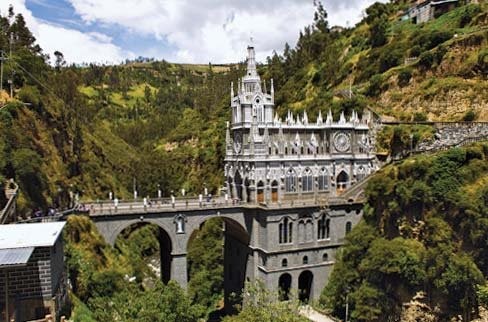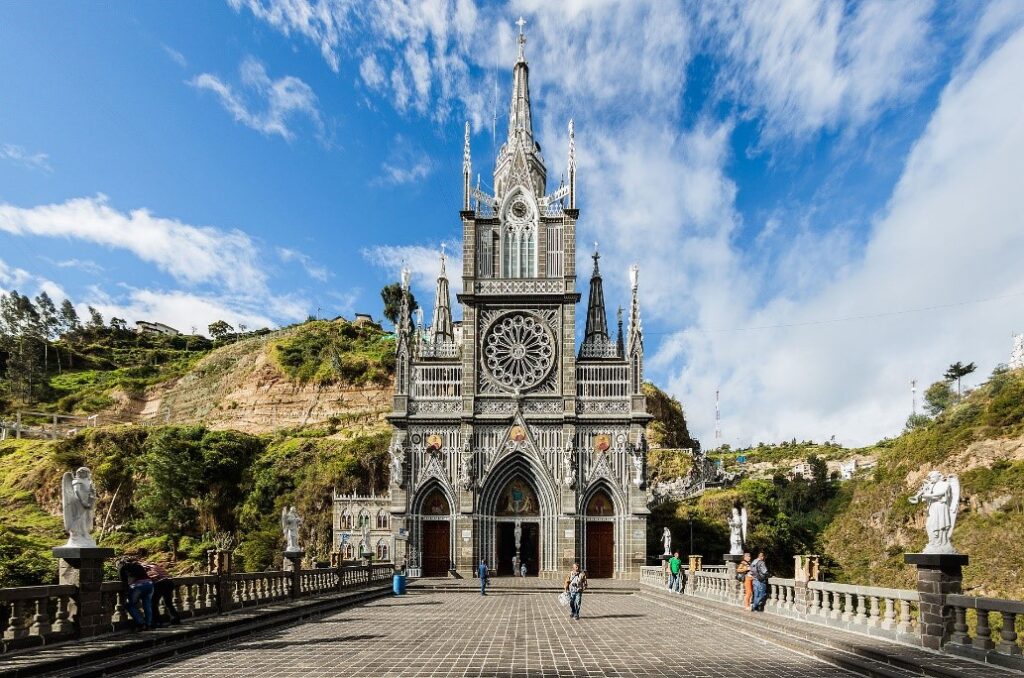Ipiales
Department
Nariño, Colombia

Flag of the city

Seal of the city

Slogan of the city
Ipiales is often referred to as “la ciudad de las nubes verdes” (the city of the green clouds) due to the occasional appearance of green-tinted clouds, particularly in the afternoons. The local cuisine prominently features the guinea pig or cavy (Cavia porcellus), known as kuy or kuwi. The city’s economic foundation is rooted in cross-border commerce between Ecuador and Colombia.
History

Ipiales, a city in southwestern Colombia, nestles within the Andes Mountains alongside the Guáitara River. Sitting at an altitude of 9,505 feet (2,897 meters), it’s often referred to as the “city of the three volcanoes.”
The city traces its origins back to 1585 when Spanish missionaries established a settlement while engaging with the native Pasto Indians. Today, its home to renowned Indian markets and the revered sanctuary of the Virgin of Las Lajas. Serving as a key regional manufacturing hub, Ipiales produces wool and cotton textiles, sisal items, and beer. Its strategic location on the Pan-American Highway, just 2.5 miles (4 km) from the Ecuadoran border, also makes it a significant border post. As of 2003, its estimated population stood at 75,403.
Geography of the city
Ipiales, a municipality located in the southwest of Colombia, belongs to the Department of Nariño and lies in the Andean highlands known as ‘Túquerres and Ipiales’. Only 3 km from the Colombia-Ecuador border and 82 km from Pasto, the city is connected to its surroundings via the Pan American Highway. This highway stretches onward to the Ecuadorian town of Tulcán, after navigating over the Rumichaca international bridge (meaning “stone bridge” in Quechua) that spans the river Carchi—known as Guaytara in the Nariño territory. This bridge can be viewed from an 800-meter-high vantage point in Ipiales.
The landscape of Ipiales is shaped by the highlands of Nariño, the Guaitara canyon, the Western Cordillera, the Cofanía valley, and a segment of the Amazon basin. Noteworthy natural features include the moors of Mueses and The Palace, and hills like Troy, La Quinta, Culachí, Black, French, Tigre, and Pax. The area exhibits varied topography and encompasses different climate zones, ranging from cold to desert to warm to temperate. With an average elevation of 2900 m, Ipiales is Colombia’s loftiest city and ranks among the highest cities globally.
The municipality is drained by three primary watersheds: Jácome Benavides, Julio, and others as documented in the municipal diagnosis of Ipiales.
1. The Guáitara River Basin, with its tributaries like the Boqueron River, Doña Juana Blanco River, Carchi, Morro, Teques or Pulcas, Orejuela, El Rosario, and Cutuaquer. As Bishop Mejía eloquently notes, the Guaytara River has deeply impacted the land and souls of the region, describing it as the “River engineer” due to its dramatic gorges, impressive canyon, and the scenic landscapes it carves over its 135-mile journey before joining the Patia River.
2. The Chingual River Basin, which in its headwaters has breaks like Chúnquer or Pun and tributaries like the San Francisco River, Green, Yamués, and The Cultún.
3. The San Miguel River Basin, fed by tributaries like the Churuyaco, Sapoyaco, Rumiyaco, Kerosene, Lora, and Rancheria rivers. Ipiales is a city situated in southwestern Colombia, close to the Ecuadorian border. It lies at approximately 0.8302° N latitude and 77.6445° W longitude. Nestled within the Andes Mountains, the city has an altitude of around 2,900 meters, or roughly 9,514 feet above sea level. Due to its high elevation, Ipiales enjoys a unique climate and boasts scenic views of the surrounding mountainous terrain.
1. The Guáitara River Basin, with its tributaries like the Boqueron River, Doña Juana Blanco River, Carchi, Morro, Teques or Pulcas, Orejuela, El Rosario, and Cutuaquer. As Bishop Mejía eloquently notes, the Guaytara River has deeply impacted the land and souls of the region, describing it as the “River engineer” due to its dramatic gorges, impressive canyon, and the scenic landscapes it carves over its 135-mile journey before joining the Patia River.
2. The Chingual River Basin, which in its headwaters has breaks like Chúnquer or Pun and tributaries like the San Francisco River, Green, Yamués, and The Cultún.
3. The San Miguel River Basin, fed by tributaries like the Churuyaco, Sapoyaco, Rumiyaco, Kerosene, Lora, and Rancheria rivers. Ipiales is a city situated in southwestern Colombia, close to the Ecuadorian border. It lies at approximately 0.8302° N latitude and 77.6445° W longitude. Nestled within the Andes Mountains, the city has an altitude of around 2,900 meters, or roughly 9,514 feet above sea level. Due to its high elevation, Ipiales enjoys a unique climate and boasts scenic views of the surrounding mountainous terrain.

Population
166 079 (2023)
116,136 (2018)
One photo representative of the city
The Las Lajas Sanctuary, formally recognized as the Sanctuary of Our Lady of the Holy Rosary of Las Lajas, stands majestically within the Guáitara River’s canyon in Ipiales, located in the Nariño Department of Colombia. This minor basilica, a Roman Catholic edifice, is dedicated to the veneration of the Blessed Virgin Mary, acknowledged as Our Lady of the Rosary.
Devotees passionately believe that the vibrant depiction of the Madonna and Child on the rock wall is divinely formed, asserting its origin to be completely natural and untouched by human hands. Constructed between 1916 and 1949, the church showcases neo-gothic architectural brilliance. The term “Laja” translates to flagstone in Spanish, drawing inspiration from a specific kind of flat sedimentary rock.
On May 31, 1951, the image was honored with the title “Sancta Virgo de Rupe” (Holy Virgin of the Rock) by a Pontifical Decree of coronation granted by Pius XII. Further, in recognition of its significance, he elevated the Marian shrine to a Minor basilica on August 30, 1954, through his decree Templum per Decorum. Pope Paul VI, on April 26, 1965, via the decree Tutela Cælestis Virtutis, designated the Marian title of the Virgin of the Holy Rosary as the Patroness of Ipiales.
This sacred site draws Christian pilgrims from Colombia and nearby Ecuador, fueled by legends of a Marian apparition from the 18th century. An intriguing tale from around 1576 narrates the miraculous experience of an indigenous woman, Maria Meneses de Quiñones, and her deaf-mute daughter, Rosa. Seeking shelter from a raging storm amongst the Lajas, Rosa astounded her mother by exclaiming “the Mestiza is calling me”, pointing to an image illuminated by lightning. This Virgin Mary’s apparition sparked widespread pilgrimage and tales of miraculous recoveries. The mysterious image deep within the stone remains visible even today.
Historical accounts, such as those by friar Juan de Santa Gertrudis between 1756 and 1764, acknowledge the presence of a shrine at this locale. Initially a modest structure made of straw and wood in the mid-18th century, it was later replaced by a brick chapel measuring 7 meters in 1795/96. Subsequently, during the 19th century, a grander shrine emerged, connecting both sides of the canyon with a bridge. The present-day church, funded by local donations, was constructed between January 1, 1916, and August 20, 1949. It stands 100 meters from the canyon’s base and spans the canyon with a 50-meter-high bridge.

Etymology
The city of “Ipiales” is located in the south-western part of Colombia, close to the Ecuadorian border. Given the region’s deep indigenous heritage, the name have its origins in the local native languages or customs.
What the city is known or famous for
Ipiales, a vibrant city nestled in south-western Colombia, is celebrated not only for its rich cultural heritage but also for its distinctive culinary delights. Among its gastronomic offerings, the city is particularly famous for the guinea pig or cavy, locally known as “kuy” or “kuwi”. This delicacy, deeply rooted in the traditions of the Andean region, offers a unique taste experience for both locals and visitors alike. Prepared in various styles, from roasted to stewed, “kuy” has become synonymous with Ipiales’ culinary identity. Beyond this, the city’s local markets brim with an array of flavours, combining both Colombian and Ecuadorian influences, reflecting its strategic location near the border. Indeed, a visit to Ipiales would be incomplete without indulging in its renowned gastronomic offerings.
